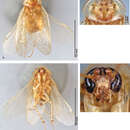Description
provided by Zookeys
Male. Measurements. Holotype TL = 16.5 mm, GW = 9.1 mm, PW = 5.00 mm, PL = 3.46 mm, TL/GW = 1.81, PL/PW = 0.69. EW = 0.20 mm; OW = 0.30 mm. Among paratypes range of TL 16.2–16.6 mm; range of GW 6.9–9.1 mm; range of PW 4.50–5.00 mm; range of PL 3.43–3.89 mm.
Head. Two ocelli very large, ovoid and protruding (0.4 × 0.30 mm); vertex dark brown with small ridges in rays around upper apices of eyes and extending onto ocellar tubercles; interocellar space concave, smooth, medium brown, lighter brown medially, with two white horizontal indentations at base of interocular space. Posterior frons light transparent brown posteriorly fading to waxy beige anteriorly, slightly concave, with horizontal corrugations; anterior frons bulbous and waxy beige; light transparent brown smooth anteclypeus. See Fig. 120d.
Pronotum. Pronotum translucent, waxy beige; dorsal surface of pronotum with short orange-brown setae that are slightly thicker laterally; pronotal pattern varying from yellow to orange-brown to dark orange-brown “panther face”, with little discernible detail; no aura. See Fig. 120c.
Body. Wing brace present. Two tarsal claws present. Legs and body light brown with darker brown maculations laterally on each sternite; subgenital plate light brown with darker margin; asymmetrical with rounded apices. See Fig. 120b.
Forewings. Wings extended well beyond abdominal apex (~40% of wing length); translucent light beige with light brown blotches; surface varies from hyaline to very slight sheen depending on specimen. See Fig. 120a.
Genitalia. Right dorsal phallomere composed of bulbous lightly sclerotized hook-shaped lobe, articulated with right ventral phallomere on lateral side; central field lightly sclerotized; medial margin more heavily sclerotized, shagreened with rough edge, edge extends into slight point one third back from posterior end; anterior end of rim forms posteriorly curving point; anterior end of margin thickened for s short distance interiorly. Small central sclerite nearly flat, nondescript in shape, finely punctate with posteriorly projecting shagreened flanges at anterior end; right ventral phallomere extends from articulation to form smooth rounded structure becoming punctate and rugose anteriorly; attached anteriorly is mildly dorsally projecting flanged concave punctate arm that extends beyond depth of rest of phallomere. Folded anterior portion of left phallomere finely setose, otherwise unmodified. Genital hook with moderate extension to pointed head with short hook; arm with distinct bend. See Fig. 121.
- bibliographic citation
- Hopkins H (2014) A revision of the genus Arenivaga (Rehn) (Blattodea, Corydiidae), with descriptions of new species and key to the males of the genus ZooKeys 384: 1–256
- author
- Heidi Hopkins
Distribution
provided by Zookeys
This species is found north of the Grand Canyon from southwestern Utah through northwestern Arizona to southeastern Nevada. See Fig. 122.
- bibliographic citation
- Hopkins H (2014) A revision of the genus Arenivaga (Rehn) (Blattodea, Corydiidae), with descriptions of new species and key to the males of the genus ZooKeys 384: 1–256
- author
- Heidi Hopkins

